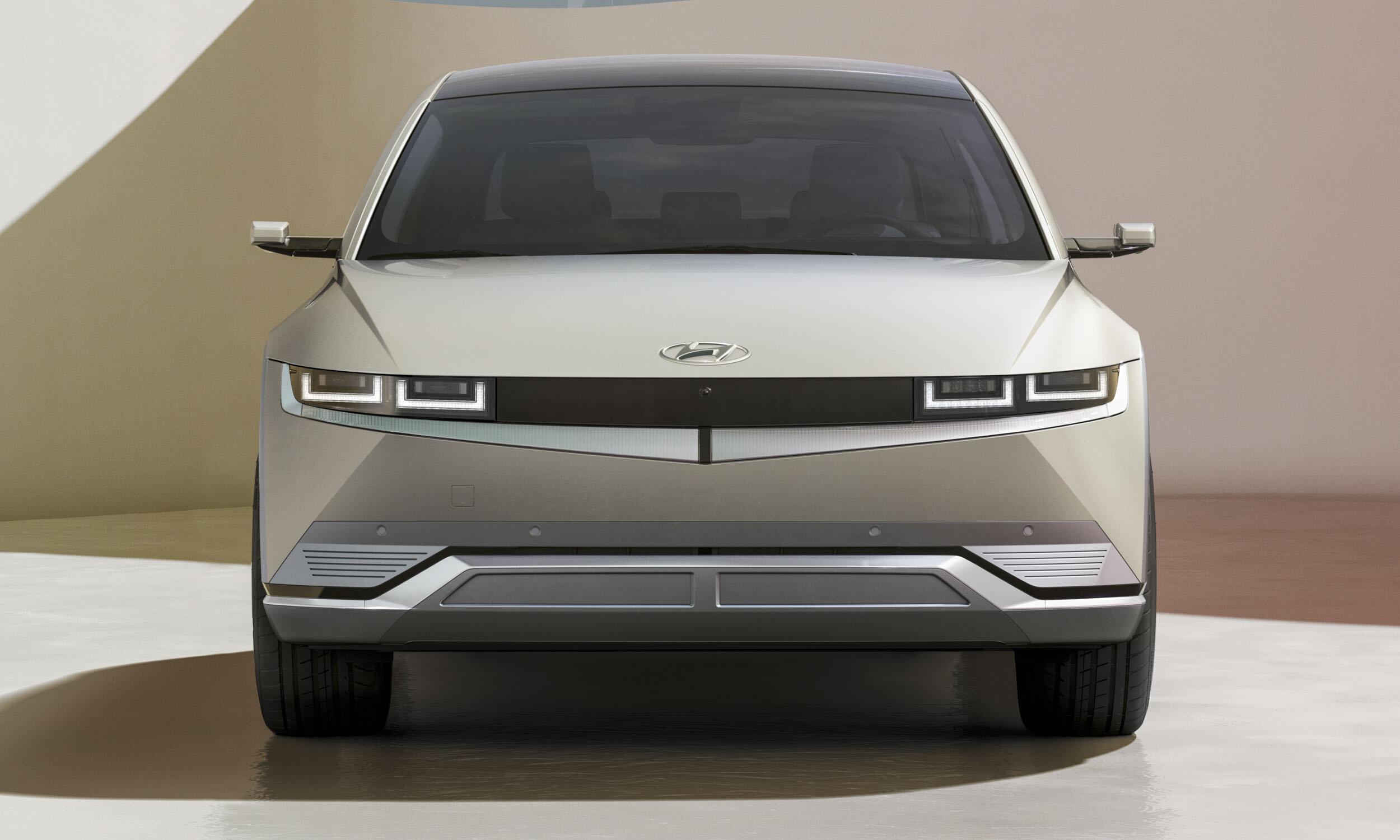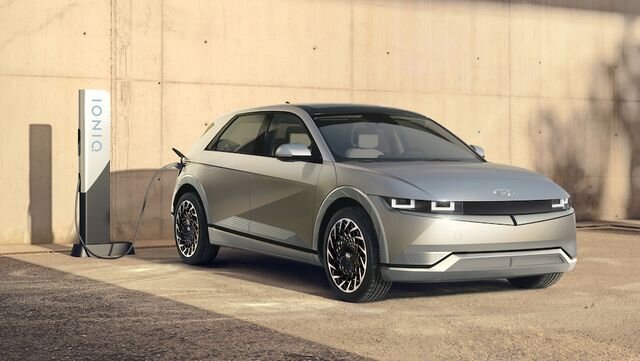Mars Touchdown and VTOLs Take Off
MOVEMENT: TRACKING NOTABLE MOVEMENTS IN MOBILITY
This month saw notable progress in VTOL companies taking off while Hyundai launched the Ioniq 5. NASA’s latest vehicle touches down on the surface of Mars. Meanwhile, back on earth, many used their vehicles creatively to bear brutal winter weather conditions across much of the interior of the US.
Originally published: March 30, 2021
Hyundai Debuts
the Ioniq 5
Hyundai’s Ioniq 5 looks set to be a real contender among the next generation of fully electric vehicles launching in the first half of 2021. The striking SUV is the first of several cars based on the company’s new Electric-Global Modular Platform (E-GMP).
While the vehicle looks like a small hatchback, its dimensions are more generous. The wheelbase is similar to a Tesla Model 3. The Ioniq 5’s sharp edges reflect the detailing that originally debuted when Hyundai showed its 45 concept at the Frankfurt Auto Show. While the 45 Concept was more pure and Teutonic in execution, the similarities are profound. The Ionic 5 has more intricate design details around the wheel arches and linear elements along the base of the doors and rear that are overly detailed and distract from an otherwise clean and bold design. But, overall, the dramatic, clean edges of the 45 Concept come through as a prevailing design element.
Few design efforts other than perhaps the Cadillac Converj Concept that led to the production version of the Cadillac ELR or the original Audi TT remain more faithful to the concept vehicles that inspired them. Other design details include lighting, which appears to be pixellated over broader underlying elements.
Hyundai 45 Concept
Hyundai Ioniq 5
The range appears adequate, with Hyundai citing a yet to be certified range of just under 300 miles. The EV supports up to 350kW DC fast charging and can get up to 80 percent in as little as 18 minutes. Both 400-volt and 800-volt charging is supported. Hyundai’s E-GMP platform offers 800V charging as standard, along with 400V charging, without the need for additional adapters.
The interior appears bright and open and supports extensive reclining seating with leg supports similar to those found in the Nio ES8.
As of this writing, pricing has yet to be released. However, with generous government rebates of up to $7,500 available to Hyundai, pricing is expected to be competitive. Things are heating up in the fully electric mid-sized vehicle segment. 2021 may be a watershed year for consumers looking to purchase a vehicle of this type.
Imagery | Hyundai Motor Company
Archer Secures New Backing
and United Airlines Orders
Archer, one of several promising electric vertical take-off and landing (eVTOL) companies, received a lot of lift this month through financial backing from Atlas Crest Investment Corporation. Archer and Atlas announced “they have entered into a definitive agreement for a business combination that would result in Archer becoming a publicly listed company. The post-closing company, Archer, is anticipated to be listed on the NYSE with the "ACHR.”
A January 13th article in “The Driven” indicated that Fiat Chrysler has also agreed to further the development of Archer’s eVTOL aircraft by leveraging FCA’s supply chain, materials, design, and engineering know-how. Archer has also agreed with United Airlines. The airline is seeking to partner with leading technology companies that will decarbonize air travel. United has placed an order, subject to United’s business and operating requirements, for $1 billion of Archer’s aircraft, with an option for an additional $500 million of aircraft. This could give travelers a quick, economical, and low-emission way to reach airports within its major hubs by 2024.
It will be interesting to see which companies will lead in the coming year or two as power constraints are overcome and short-term regional and inner-city travel market demand takes off. Various companies, including Joby Aviation, Hyundai, and Uber’s joint venture, Kitty Hawk, Lillium, and EHang, are all set for take-off.
View the full Archer press release.
Imagery | Respective eVTOL Companies
High Drama and Perseverance
on the Red Planet
On February 18th, 2021, NASA’s Perseverance rover touched down on the surface of Mars in a dramatic fashion. Utilizing a new sky crane deployment method, the landing involved hundreds of critical steps to culminate in the successful deployment of the rover. NASA and JPL staff were jubilant as images confirmed the success of the complex maneuvering that had only been visualized in impressive animation sequences.
Bird’s eye view from sky crane as Perseverance was deployed
In addition to carrying out an intricate and innovative landing sequence, NASA has developed a helicopter named Ingenuity that will be capable of flying through the Martian atmosphere which is quite an accomplishment. The atmosphere on Mars is about 1% the thickness of Earth’s making flight of the probe a serious challenge.
NASA Ingenuity Helicopter
The successful landing will allow the largest of NASA’s Rovers to complete a range of missions in terrain previously unreachable by prior rovers. According to NASA, the rover will characterize the planet’s geology and past climate and be the first mission to collect and store Martian rock and regolith (broken rock and dust). Subsequent NASA missions, in cooperation with ESA (the European Space Agency), will send spacecraft to Mars to collect these cached samples from the surface and return them to Earth for in-depth analysis.
Explore More of the Mars Mission
Imagery | NASA
MORE MOVEMENT
Would You Like
Mustard With That?
The bivouac has been enjoying dynamic visualizations and storytelling from the Mustard channel for some time now. Mixing a unique three dimensional visualization style with informative kinetic diagrams, this content provider highlights what it took to get some of the most unique forms of mobility up and running. In the latest installment, Mustard outlines just what brought about the world’s largest cargo air-lifter.
Check out the Mustard channel for more spicy storytelling and visualizations.
Texans Use New Ford F-150s to Power Homes During Blackout
While the new Ford F-150 may seem largely evolutionary in its design, various innovations lie within the new model. These include lie flat seats and reconfigurable workspaces in both the center console and tailgate areas.
Perhaps most impressive is the ability for the new truck to generate on-board power. Many experiencing brutal winter conditions in Texas last week were using this innovation to address portions of their home power needs during the state-wide blackout. It is good to see that vehicles can be used like this in critical conditions. This kind of utility comes from applying design thinking to keep the needs of the customer in mind throughout the design process.
The PowerBoost Hybrid truck is equipped with the more robust 7.2-kW Pro Power Onboard Generator power supply, which Ford says can simultaneously power stuff like a plasma cutter, TIG welder, air compressor, angle grinder, and work light (all of those!) for 32 hours. A 2.4-kW generator is standard on PowerBoost hybrids, and comes with two 120-volt, 20-amp outlets in the bed that can power two heavy-duty tools for 85 hours straight on one tank of fuel; the 7.2-kW unit also adds a 240-volt outlet.
In addition to helping hard working folks on job sites, this kind of innovation is proving essential in the face of increasing unpredictable climatic events.
Images | Ford
USPS Unveils
New Postal Delivery Vehicle
The United States Postal Service has selected Wisconsin-based Oshkosh Defense to produce the bulk of next-generation postal delivery vehicles. While many had hoped that most new vehicles would be electric, initially, only 10% of the new fleet will be battery-electric vehicles. With considerations for future retrofitting to electric capabilities, the Postal Service mentioned some vehicles might be retrofittable as electric power platforms and charging standards continue to emerge.
A quick (re)designbivouac based on electric skateboard form factor
The 10-year contract starts in 2023, so the current administration may still make modifications to the design or balance of the fleet. Current postal vehicles have been on the road for as long as 30 years, and lately several have caught on fire.
The new design is far friendlier to postal workers. Luxuries like standing height loading bays and air conditioning are new features. Safety features are also updated with extensive cameras providing better situational awareness, and features like airbags and forward collision are included. New telematics packages will also be available, hopefully empowering the fleet to operate more efficiently and safely.
Images | Pixar…no wait…USPS
Lucid Motors to Go Public
through SPAC Merger
Lucid Motors will become a publicly traded company on the New York Stock Exchange in a deal that will leave the electric vehicle startup with $4.4 billion in cash. The California startup, majority-owned by Saudi Arabia’s sovereign wealth fund, plans to ship its luxury electric Lucid Air sedan later this year.
As with many companies, there have been delays caused by the COVID-19 pandemic, but the company recently assured those who have ordered vehicles that they remain focused on ensuring the quality of the initial run of vehicles but that they won’t likely be able to ship them at the rate they had hoped to by Spring of 2021.
Sleek Lucid Air Sedan
Lucid Gravity SUV
Lucid Motors states that it should be able to generate gross profits as soon as 2023. That is when their Gravity SUV will become available, and that vehicle should be instrumental in getting them in the black by 2025. It expects to be able to make and sell 20,000 cars in 2022, 49,000 in 2023, and as many as 500,000 cars a year (including the Air, the Gravity SUV, and future models) by 2030.
Images | Lucid Motors
Images credits: Hyundai, Archer, NASA, Ford, USPS, Lucid Motors











